Who is Philip Surrey?
Who is Philip Surrey? He remains a challenging artist to understand. Surrey is an artist who describes vulnerability, loneliness, mystery and sometimes even the triste. With our own musings here, we invite and encourage more study of Philip Surrey and his important contribution to Canadian art.
Contents
Philip Surrey Paintings for Sale
2004 Philip Surrey Restrospective Exhibition: Galerie Walter Klinkhoff
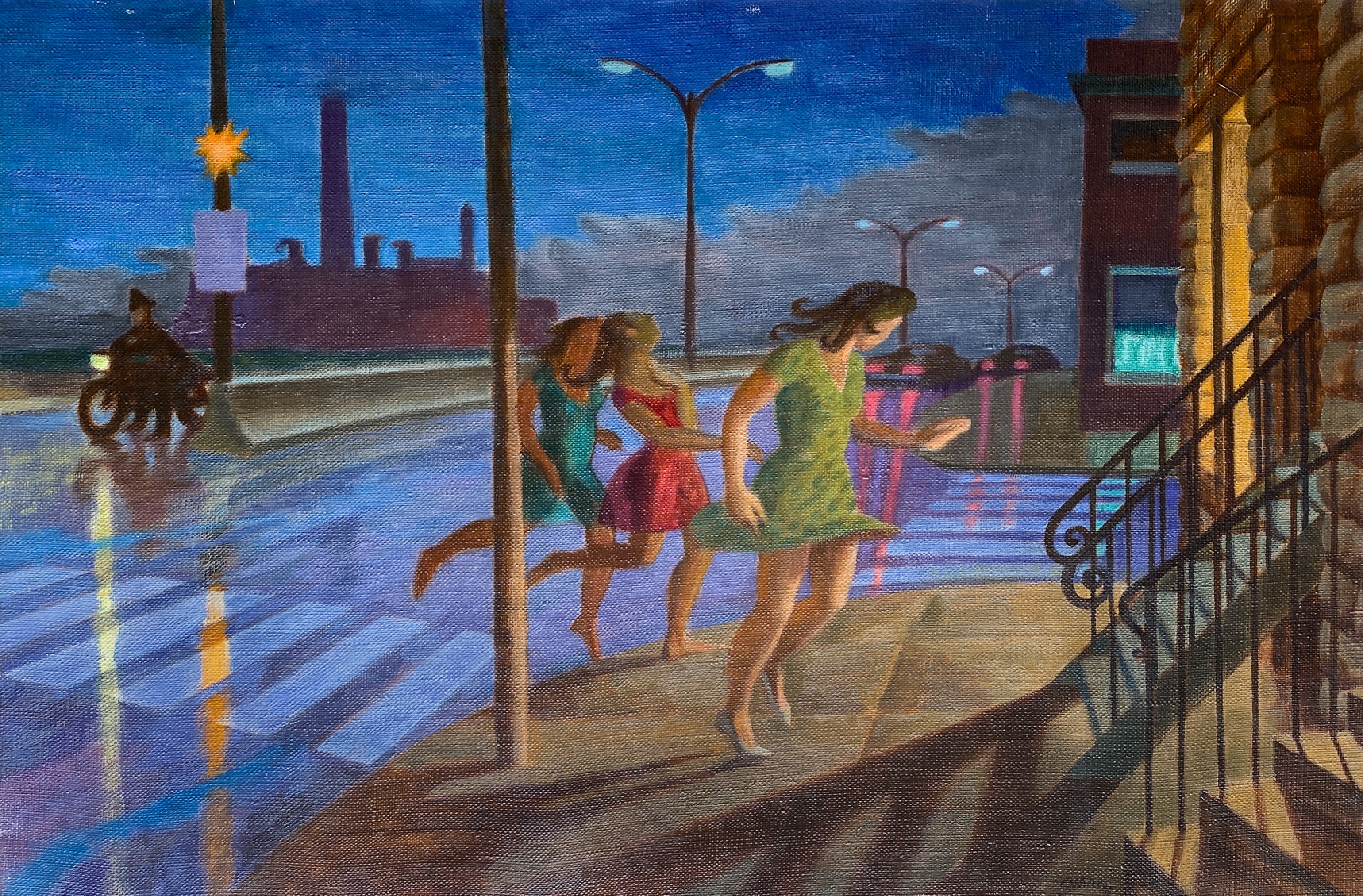
Three Girls. Oil on canvas, 18 x 24 in (45.7 x 61 cm).
Private collection, not for sale.
Introduction
Our intentions here are to offer our ideas as to areas of study we think pertinent to a larger study of Philip Surrey, optimistically by a team of trained art historians. Our contribution is personal, written from the perspective of one who was acquainted with Philip Surrey, visited him several times, sometimes when I managed to purchase a work from him, one who has bought and sold his work in the market for more than four decades, one who has been extremely attentive to Surrey works sold elsewhere over that same period of time and who, not incidentally, is a collector of his works in various medium purchasing them from various sources. I may even be alone in having this combination of experiences with Philip Surrey.
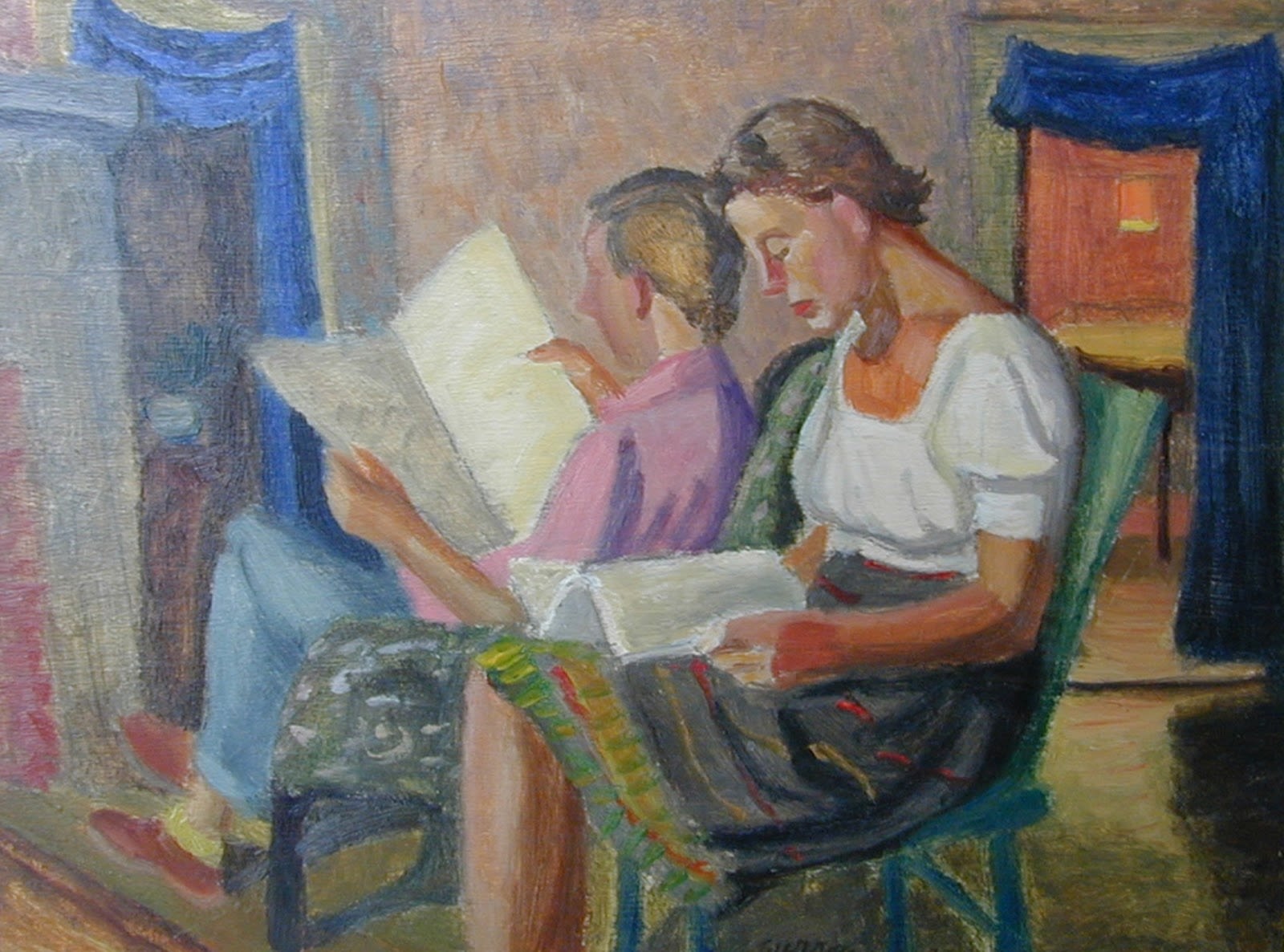
Margaret and Philip Surrey, Oil, 12 x 16 in (30.5 x 40.6 cm).
Private collection, not for sale.
The following quotes are taken from Philip Surrey’s “autobiographical” notes, ones actually penned by his wife, Margaret Surrey. All but the first quotation below, in which Margaret refers to herself, are written about Philip in the first person:
"The idea of my writing this began when I realized one day that sometime someone might want to write about Philip and since all his relatives are dead and no one but myself knows anything about who he is or where he came from, I had better get the information down before we are both dead. It is simply a loose narrative, using information got from Philip himself concerning his life before we met, then my own memories plus the diaries I have always kept."[1]
"On June 23, 1964, John McConnell asked me if I would not like a chance to paint full time before leaving this world. He suggested that I stay home and paint but still remain on the staff of the Weekend Magazine and get my full salary as usual thereby enabling me to work without worry over sales and money...We [Margaret and I] have had wonderful breaks and periods of unbelievable happiness. Our dearest wish was simply handed to us."[2]
"They [my paintings] are lit by artificial light of various colours, and, for me, the twilight has a special charm. Two or three kinds of light from different sources increase the complexity but also the interest of the problem."[3]
"I cannot work quickly. I work my paintings out painfully, four or five at a time, a little bit of work on one, a bit on another: so difficult that sometimes I wonder why I put myself through all this. And yet, I repeat, I can't stop."[4]
"[to live with danger] is manifested in the reluctance or inability of a person to envision his own death even though he sees the threat all around him...This trait enables us, despite the statistics of traffic deaths, to drive with peace of mind."[5]
"One aspect of my character which puzzled my wife after our marriage was my deep-seated pervasive feeling of loneliness...When I married, there was a problem...I wanted Margaret to be with me too much and it took awhile for us to understand the situation."[6]
Philip Surrey was well served for a number of years by Montreal based art dealer Gilles Corbeil. Prior to Corbeil, Gilles Gauvreau, first with Galerie Martin and then later at his own gallery, had worked closely with Surrey. When Gilles Corbeil was tragically killed in 1986, I think it was, in a car accident while vacationing in Australia, I thought that perhaps Surrey might welcome an overture from us for our gallery to represent him. I took it upon myself to see what I might accomplish for Galerie Walter Klinkhoff. Anyone who has visited the Surreys will know what I am referring to when I write of Margaret, opening the front door of their Grosvenor Avenue home, behind her glasses, eyes wide open, unblinking with an expressionless stare, cold, as if she was looking through and beyond, with few words would usher one inside and then disappear as Philip came in. Margaret Day Surrey has her own story of great interest. Patricia Whitney wrote that Margaret gave up her own ambitions to create for Philip "...the kind of oasis of calm where his talent would emerge."[7]
Philip was content not to have an official arrangement with any dealer. I tried to receive work from him in a piecemeal fashion several times, using it as an excuse to get in the door that I wanted to show him one of his paintings we had purchased. By 1986, his best work may have been behind him, but he was still doing some good work. Paul Kastel and Tony Nevin had better luck than we did. I recall that they had a very fine and successful Surrey exhibition, primarily of works on paper, a good number of pastels and mixed media works. My father told me one handicap I had in my initiative. Relatively early in Dad's career, Philip had approached him to gauge his interest in showing his work. Dad rejected him, not because he did not like the work, but with business very slow in those years at that time he feared taking on the responsibility of making a living for an additional artist.
Philip and Margaret Surrey were extremely private. A colleague of yesteryear, Dan Delaney, of the now defunct West End Gallery in Westmount, Quebec about Surrey was quoted, "There was something special about him. I don't think anyone really knew him that personally."[8] He was rarely forthcoming in providing any information about his paintings, beyond occasionally suggesting when the work may have been painted. As an example, a gentleman we have known for 50 years, a man who back in the day owned more Philip Surrey paintings than anyone I know, told me of Philip's acceptance of an invitation to his home to visit his collection. Surrey arrived on the designated date and time and politely greeted his host. Surrey slowly walked about the extensive collection. Without a word about any of the paintings, at the end of his tour, Surrey, with the same courtesy as when he arrived, thanked his host and left. That's it.
The biographical notes which are publicly available, lodged with the National Archives posthumously do occasionally offer insight into his work. The (auto) biography does reveal in detail his method of painting, bouts of depression, both Philip's and Margaret's, excessive drinking, suicidal thoughts, biographical details of his childhood, Philip's analysis of the roots of his loneliness, much of which affect his artwork. Although it rarely says anything about individual paintings beyond a logging of dates working on various subjects, this is an invaluable resource to any attempt to understand Philip Surrey's paintings. In most cases, it is extremely difficult to match the ledger notations with precisely what painting he is resolving. Curiously, what reads as autobiographical and written in the first person, is penned by Margaret Surrey. "It is simply a loose narrative, using information got from Philip himself concerning his life before we met, then my own memories plus the diaries I have always kept"[9], reads her Foreword.
In the narrative, we meet with several artists and personalities including Emily Carr, Paul-Émile Borduas, Alfred ("Fredo") Pellan, Fred & Maude Varley, John & Corinne Lyman, Jeanne Rhéaume, Frank & Marion Scott, Goodridge Roberts, Pauline Julien, Pierre Trudeau, René Richard & his wife Blanche, Jori Smith & Jean Palardy, Madeleine & Jean-Paul Lemieux, Gabrielle Roy, Robert LaPalme, and Mavis Gallant.
Montreal WestEnd Gallery's Dan Delaney perceptively commented about Surrey's artwork, "There was always a question to be answered and the viewer had to look within himself to answer."[10] Surrey's paintings are neither simple nor easy works.
Margaret wrote in his person:
"A work of art is a particularly complex statement, valuable because packed with meaning...Like icebergs, four-fifths of our personalities lie below the surface; of the fifth that shows, only part can be expressed in conversation. The only effective outlet for all deeper feelings and thoughts is art."[11]
"In 1958 I was invited by the Department of Transport to go to the Arctic aboard the icebreaker d'Iberville...bound for Resolute Bay...I began painting 6 x 8 oil sketches…"[12]
"The colours of sea and sky and icebergs ranged from coldly subtle to harshly brilliant."[13]
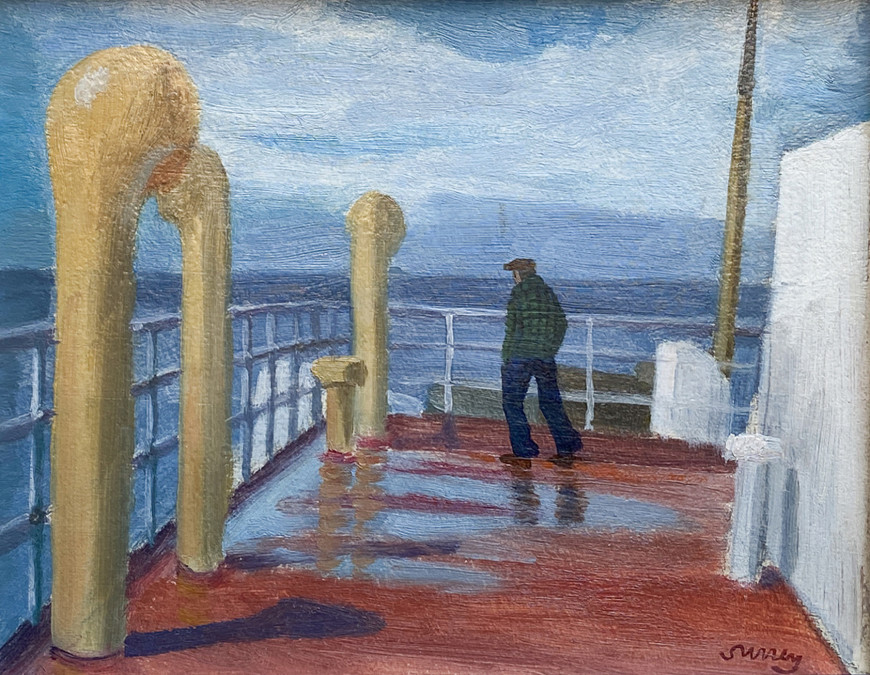
The Strait of Belle Isle, 1958, on board the icebreaker CGS d'Iberville.
Oil on masonite, 6 x 8 in (15.2 x 20.3 cm).
This painting is available (more details).
After Philip and Margaret's passing, I did only a little bit of consulting for Margaret's nephew, Nicholas Simpson, their only beneficiary. Years later, in 2004, Nick was supportive of our initiative at Galerie Walter Klinkhoff to a "Homage à Philip Surrey". Philip Surrey is an artist who holds enormous intrigue for me. I am of the opinion that there is a lot to uncover through a study of his paintings, his work habits and his psyche. Knowledgeable American art collectors sense the anxieties and loneliness of Edward Hopper in him. Gilles Corbeil perceptibly added the works of Alex Colville, Jean Paul Lemieux, Balthus and Magritte to the discussions as to who is Philip Surrey.[14] Surrey, Hopper, Lemieux and Balthus rarely offered any serious interviews or wrote about their work, making further study potentially especially rewarding.
The Urban Dweller
"In many of my pictures there is a man walking by himself, that man is always me."[15], metaphorically Philip Surrey said.
"The city is his place. Night is his time, and the overwhelming solitude of man his theme.... Apprehension and fear lurk in the threatening shadows, but the greatest terror is loneliness."[16] - Robert Ayre on Philip Surrey
Philip Surrey was a pedestrian, walking to and from work at the Montreal Standard and then later the Montreal Star where he helped develop the Weekend Magazine. In 1964, when Philip was 53, "John McConnell [the publisher of the Weekend Magazine and Montreal Star] called me in and told me to go home and paint and the company would continue to pay my salary."[17] "On June 23, 1964, John McConnell asked me if I would not like a chance to paint full time before leaving this world...He said that he 'wanted to do something for Canadian art', which was a very flattering remark."[18]
With this liberation "The whole of our lives changed. Everything came together…"[19]
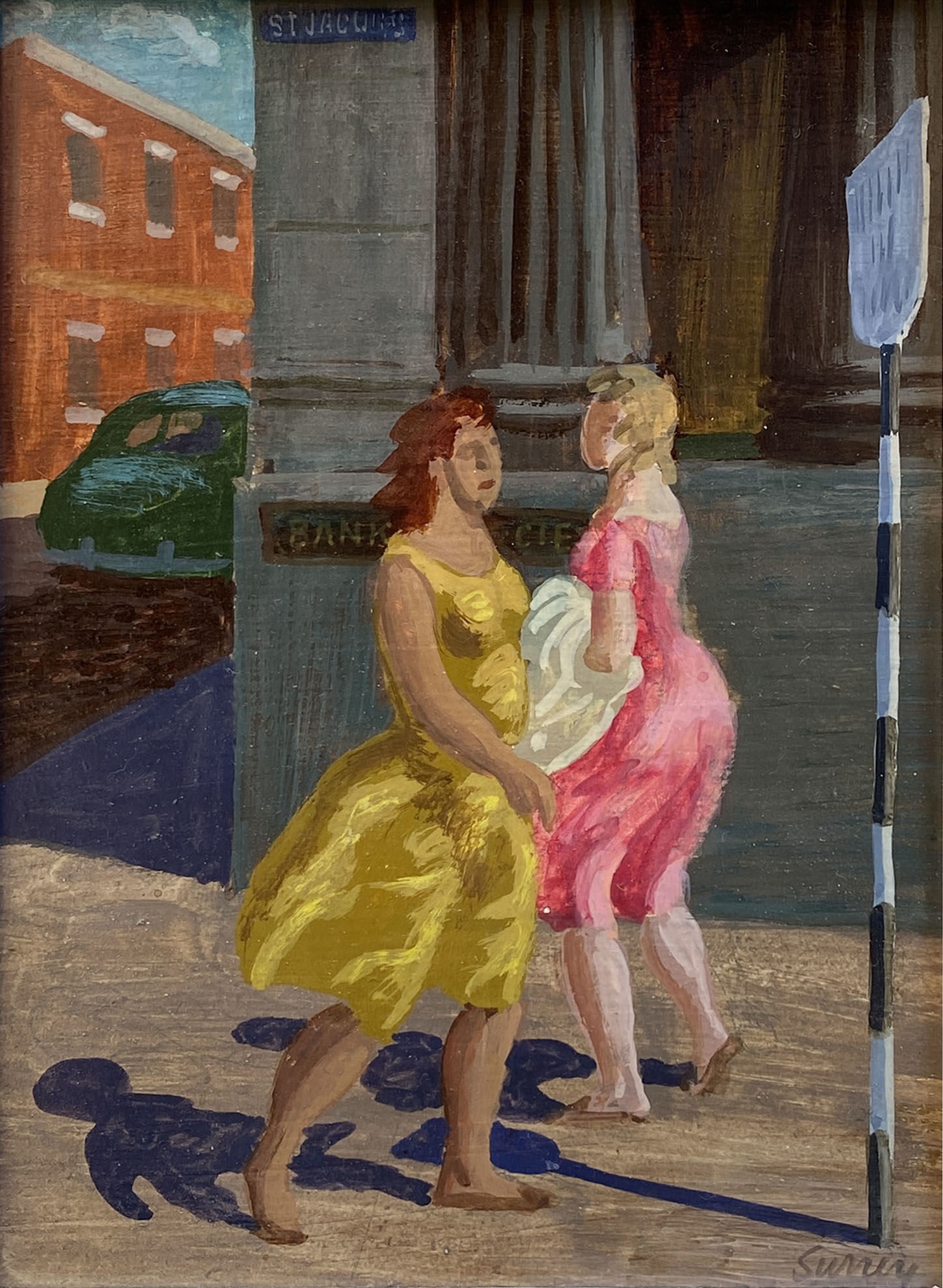
Bank Girls, St. Jacques Street, Montreal.
Oil on board, 8 x 6 in (20.3 x 15.2 cm).
This painting is available (more details).
Some art enthusiasts newly introduced to the world of Philip Surrey might think that since the 1940s the artist has been painting simply innocent interpretations of pedestrians, automobiles and buses in the urban environment.
Vie des Arts' Gilles Daigneault gave us an astute insight in 1979 when he wrote of an interview and conversation he had with Surrey, "...there is one thing that occupies a special place in the artist's imagination and which he often uses to express what he resents most: the automobile."[20] We need remember that in the post WWll period car ownership grew enormously allowing the development of the suburbs and reorientation of the urban core. One commuted to and from home in the new suburbs to work downtown in one's car on the extensive network of highways and expressways North American cities developed in the postwar era of urban renewal.
In Pedestrians, Crosswalk (Dominion Square, Montreal), circa 1953, the design grill of the car approaching the intersection resonates Daigneault's observation. His pedestrians are menaced by motor vehicles, a notion increasingly popular in the 21st century. Surrey's cars and his pedestrians, particularly his women, harbour intentions and anxieties beyond documentary or good composition.
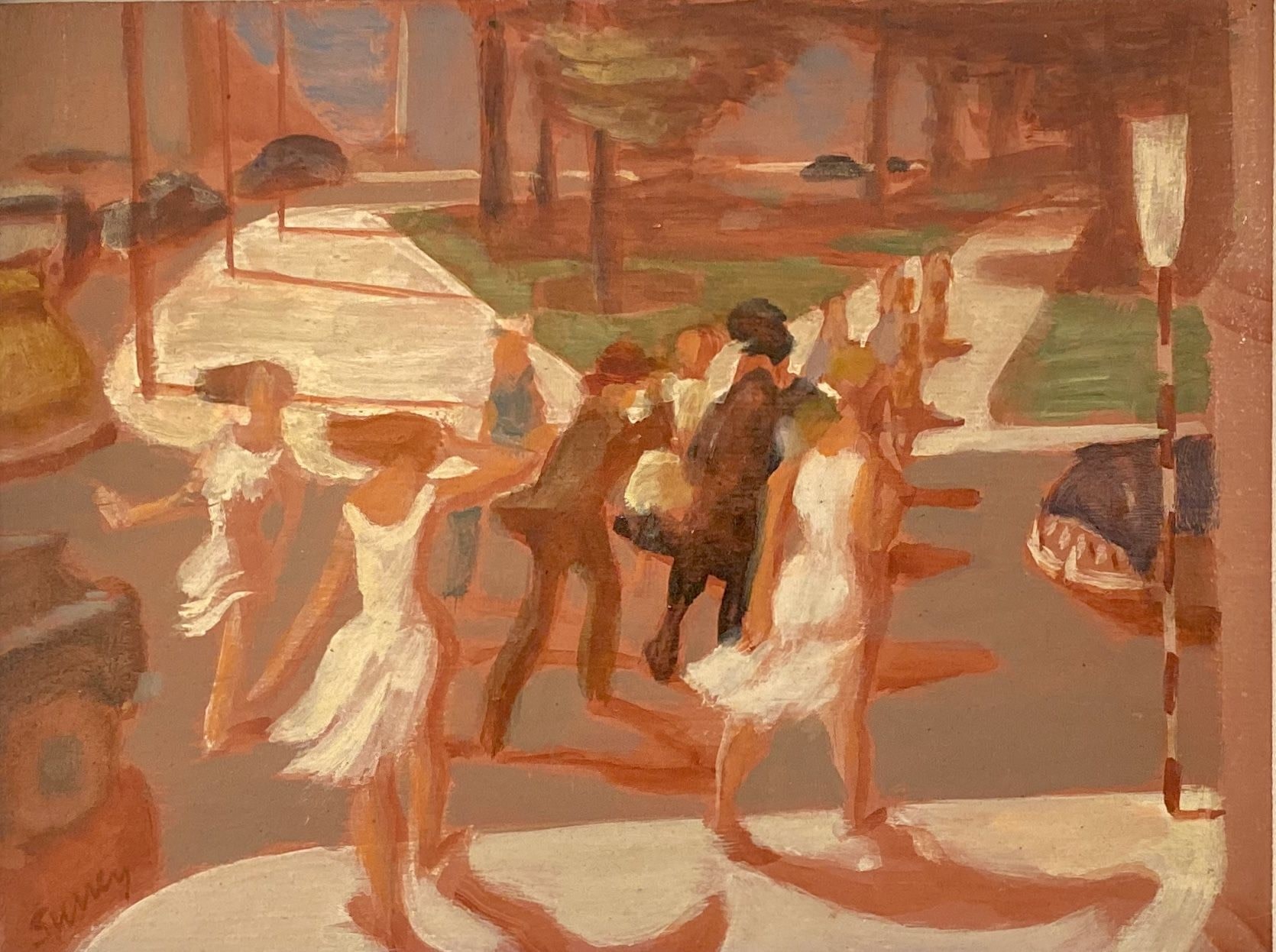
Pedestrians, Crosswalk (Dominion Square, Montreal), circa 1953.
Oil on wood board, 6 x 7 3/4 in (15.2 x 19.7 cm).
Private collection, not for sale.
Until Philip Surrey was "liberated" from the obligations of work at the Weekend Magazine, most of his drawings and paintings were the product of early morning or evening light, before or after work. His walks to and from the newspaper provided him with ideas, some that he drew immediately and others later from his recollection of the event or idea. The new freedom from an office in 1963 allowed him walks during the daylight and introduced new potential to his palette. While in some paintings, initially, imagery appears festive, ".... if you just open your eyes"[21], they suggest tensions similar to ones expressed in his darker evening paintings.
It would take little imagination to hypothesize that the crosswalks and intersections we regularly see in his paintings suggest zones for him and his fellow pedestrians where they are to be safe from the threats posed by cars and trucks.
That the artist sometimes sketched his figures naked, clothing them as the work evolved likely accounts for Surrey's sensually diaphanous dresses on some of his women. This work habit may imply other anxieties Surrey experienced. Place Victoria Square is an example of a very preliminary mixed media study for one of his Place Victoria paintings.
Jerrold Morris reproduced a large drawing, "Study for Place Ville Marie", showing a dozen nude figures in The Nude in Canadian Painting, in 1972.[22]
With an offer by Jerrold Morris in August of 1963 of an exhibition in his new Toronto gallery, Surrey, having recently been depressed and unable or disinterested in painting, found new motivation. "Now I want badly to get to work. I would like to do something with Place Ville Marie and the girls who flock in to the Square there at noon."[23]
In the 1965 painting titled Place Ville Marie, note that on the lady in the yellow dress, the artist neglected to complete painting the front of her shoe. But her foot is clearly described. One could reasonably hypothesize that the artist clothed her later.
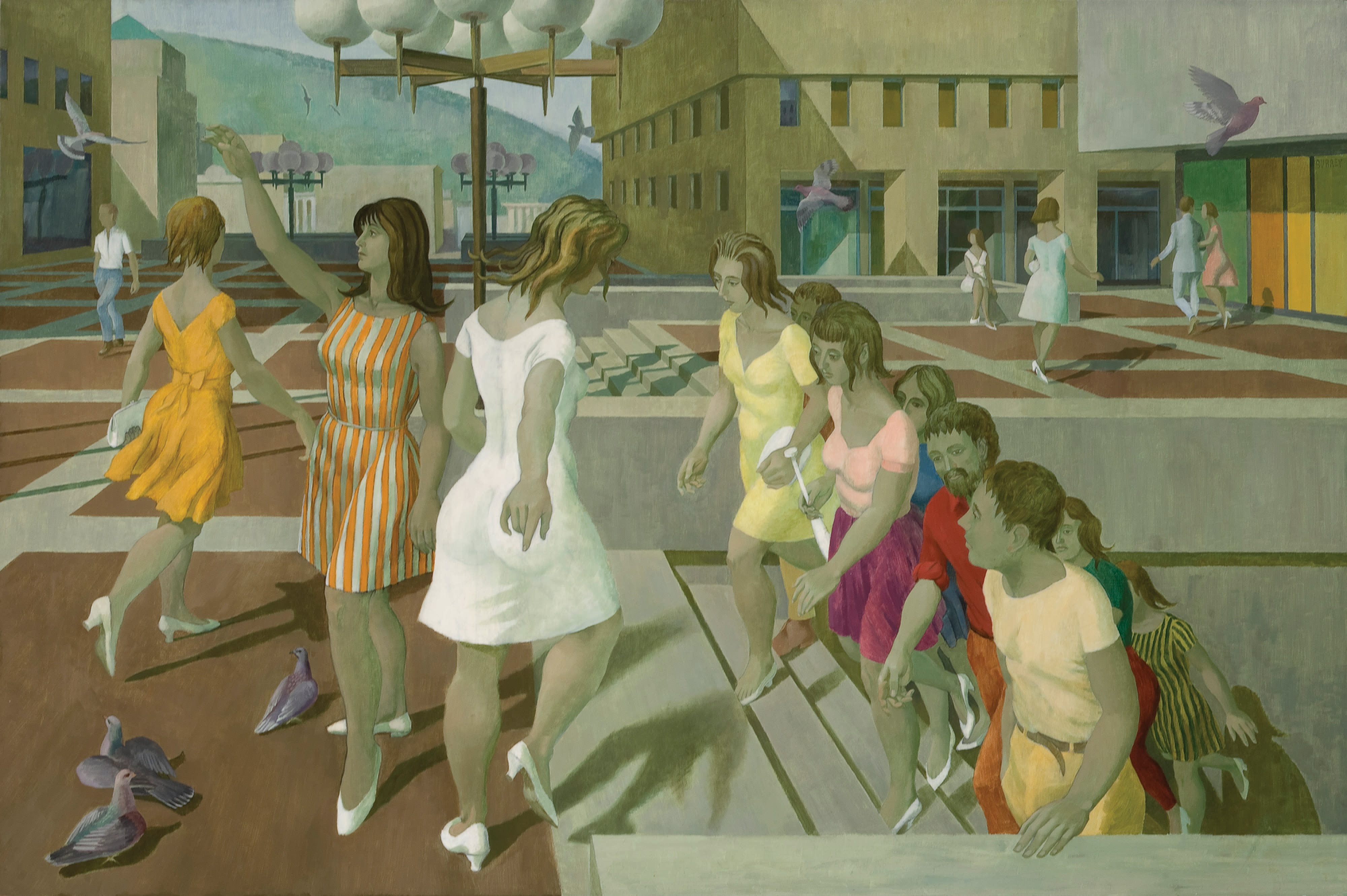
Place Ville Marie IV, 1965. Oil on masonite, 32 x 48 in (81.3 x 121.9 cm).
Ex. collection John McConnell, Publisher of The Montreal Star who had "liberated" Surrey from his office in 1964.
Private collection, not for sale.
With the above in mind, we can better appreciate his dealer, Gilles Corbeil's comment: "We are not far from the world of Magritte and Balthus..."[24] In the Canadian context, in our opinion, Surrey would be a good study to compare and contrast with the work of Alex Colville and, as Gilles Corbeil suggested, Jean-Paul Lemieux.
In Grosvenor Hill, the winter stage is Surrey's own street. There is a geometry in forms of the houses and their exterior staircases, diagonals, squares and rectangles. and the polka dots of red taillights. An ominous net-like foliage from above mysteriously envelopes the scene as a lone grocery shopper makes her way home. That this is Surrey's street is of little importance perhaps beyond providing him the original material to inspire his painting. His end works are simplified and generalized in many ways resulting in a composition that represents any number of city streets and places.
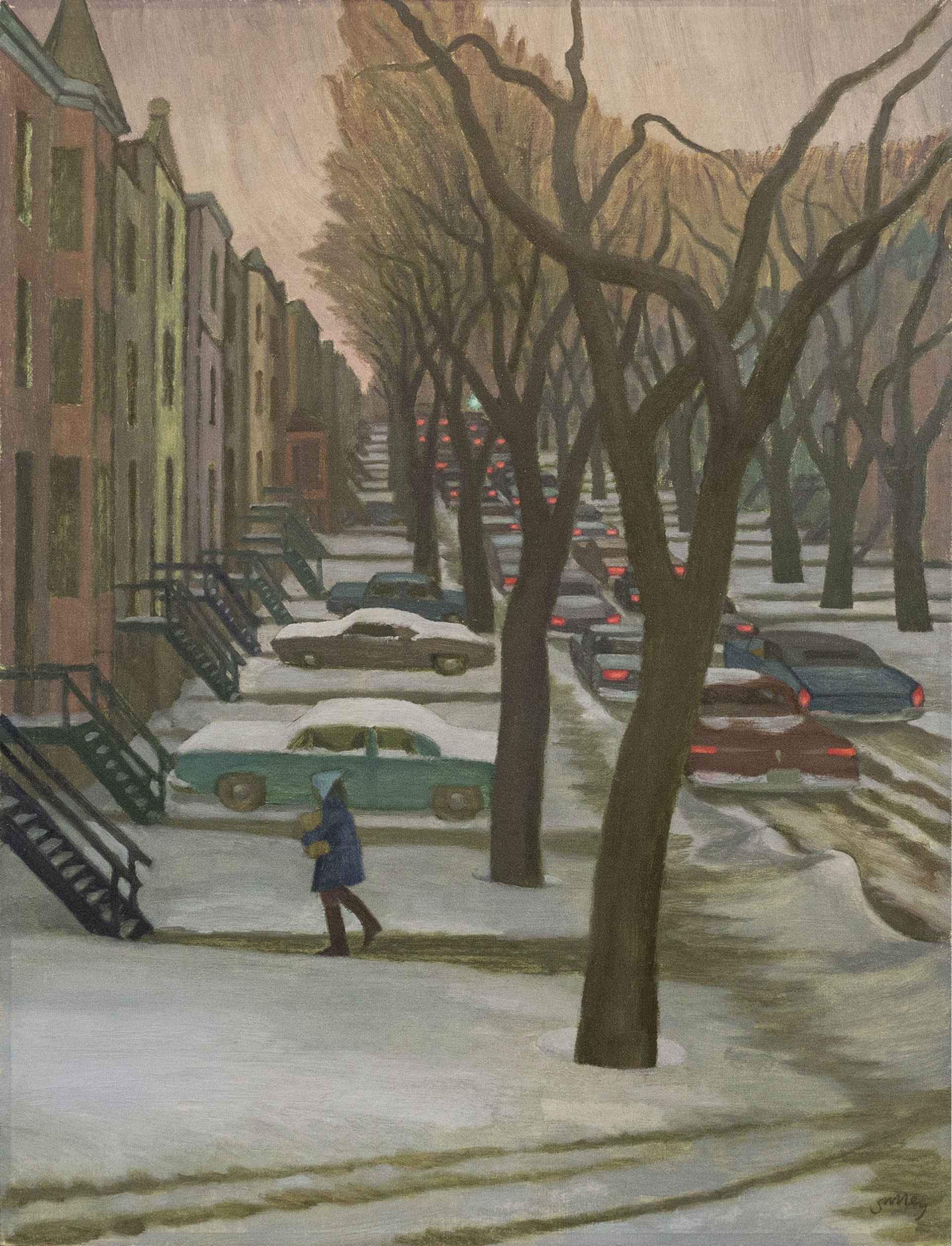
Grosvenor Hill, Westmount, 1967 (circa). Oil on board, 24 x 18 in (61 x 45.7 cm).
Private collection, not for sale.
In Winter Night, another one of our paintings, a lone female is walking up the street on a blustery winter's evening. A few steps behind her on the sidewalk, is a lone male, the metaphor for the loneliness of the artist. Further behind, is a procession of cars with their headlights glaring. In the spirit of the surreal overhead street, lights are without footings. (Although untitled, it is my opinion that the location is also Grosvenor Hill, Surrey's street, with the perspective just north from Westmount's Sherbrooke Street looking south west. For those of you familiar with the area, at the intersection on the lower left today, located today on the southeast side of Grosvenor and Sherbrooke streets is an Esso service station.)
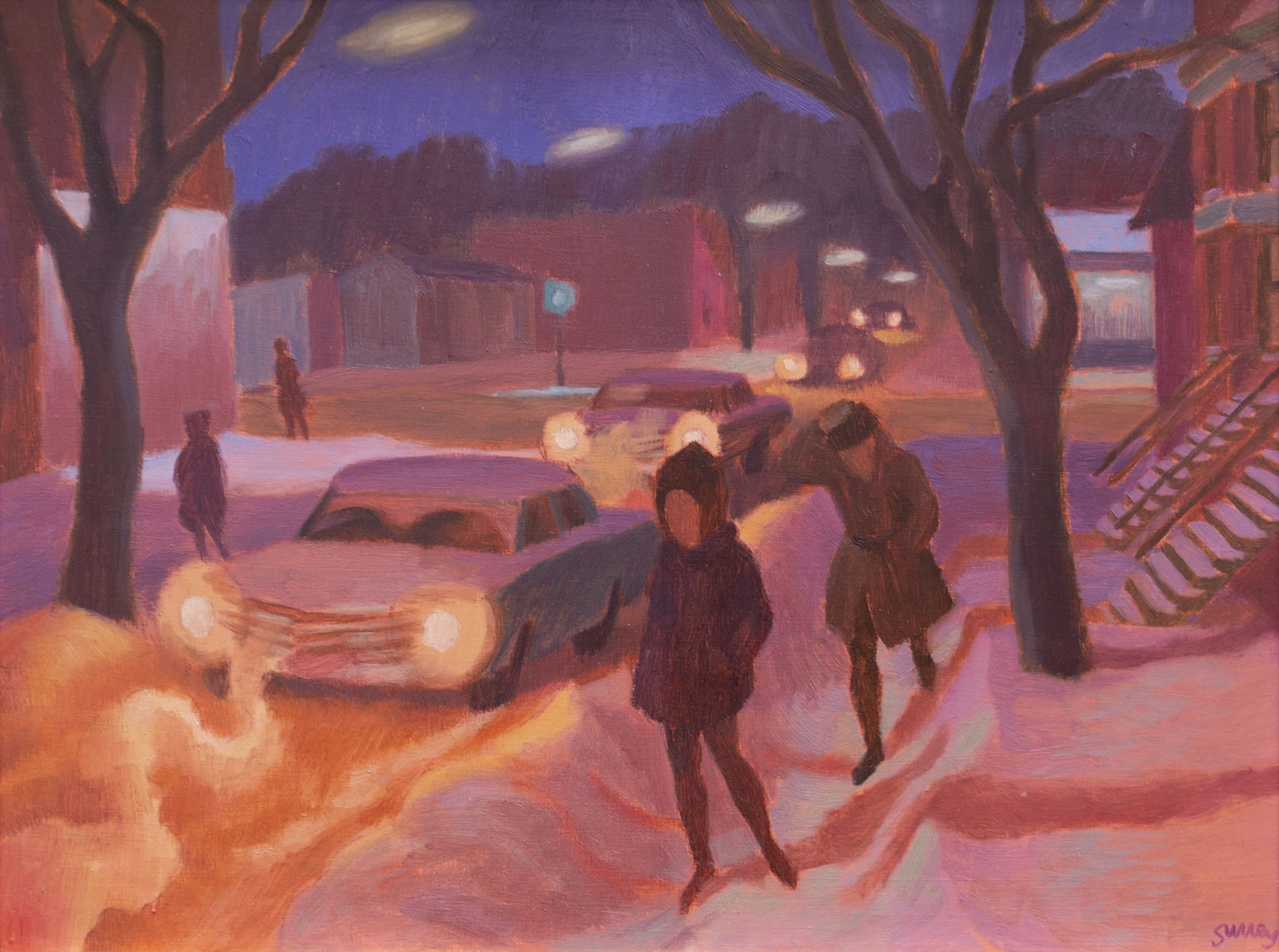
Winter Night, 1965 (circa). Oil on masonite, 12 x 16 in (30.5 x 40.6 cm).
Private collection, not for sale.
In Winter Street Scene we find a lone woman, fighting one of winter's nasty winds. One can only speculate that Surrey's characteristic lone male is the figure sheltered in the car conspicuously noticeable behind the windshield. In the manner of the surreal two of the traffic lights are without any support. Is the glaring red a warning of impending misfortune? This is but one of the questions worthy of additional study.
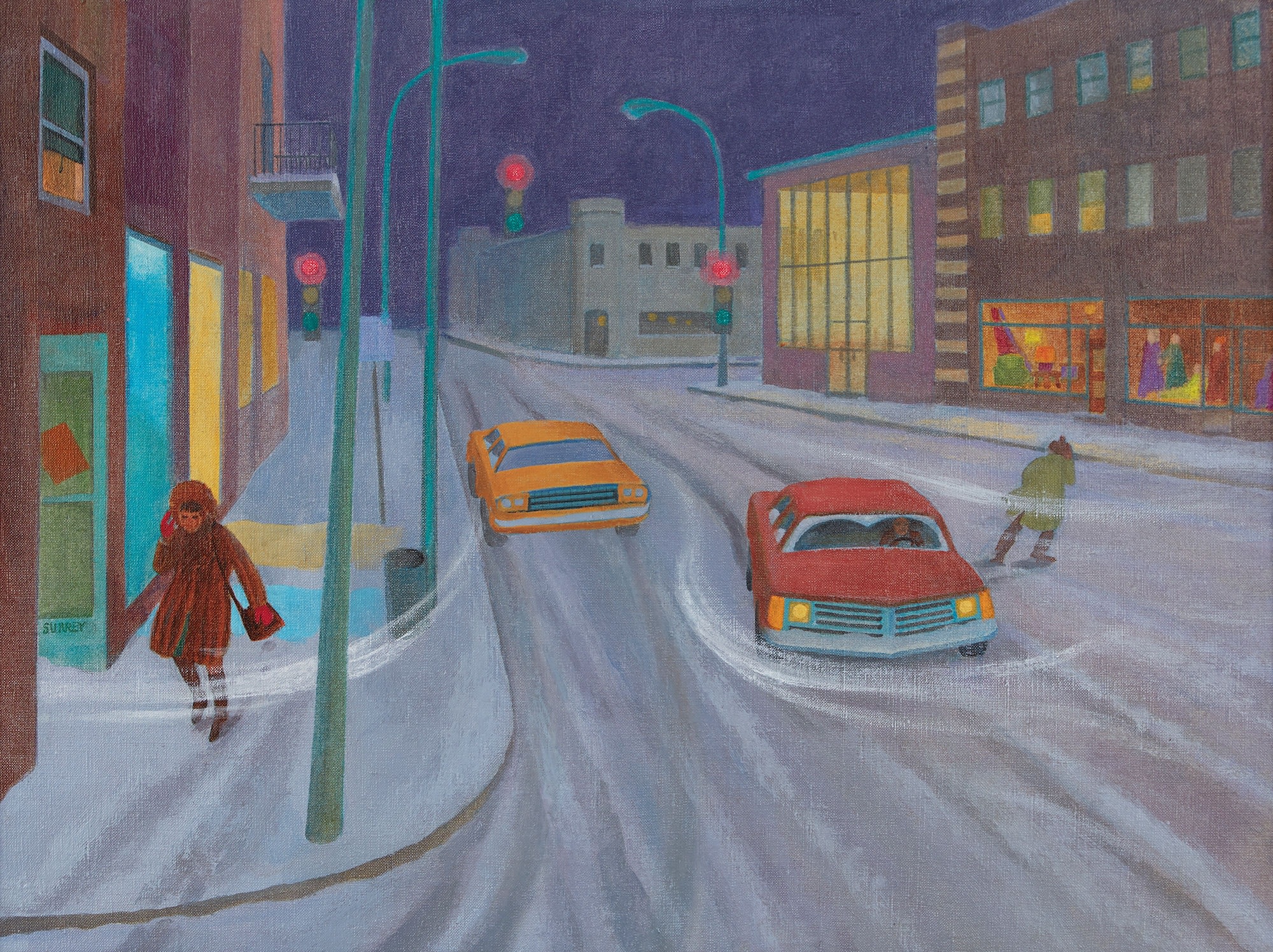
Winter Street Scene. Oil on canvas, 18 x 24 in (45.7 x 61 cm).
This painting is available (more details).
In his interiors, there too, we often find a man alone. There is no evidence to suggest that his works are autobiographical. However, anyone who has ever spoken to a newspaper man of Philip's generation would understand it not uncommon for the reporters to repair to one of the neighbourhood taverns for an ale at the days' end. Terrapin Tavern, inspired by The Pundit was located on Place d'Armes Hill (Côte de la Place d'Armes), a 3-minute walk from Surrey's office at the Montreal Star building on St. Jacques Street. This scene and several others of this type which he painted at other named taverns are events that he had no doubt observed. With the cameo appearance of the artist seated alone, make for him outstanding composition serving to emphasize his sense of loneliness and perhaps his notion that this is a condition shared by many other urban dwellers.
The Hockey Fan
Philip Surrey was a hockey fan. Terry Rigelhof tells us that it was his colleague, the sports columnist over at the Montreal Gazette, and Hockey Hall of Famer, Dink Carroll, who gave him the ticket to the seats along the boards.
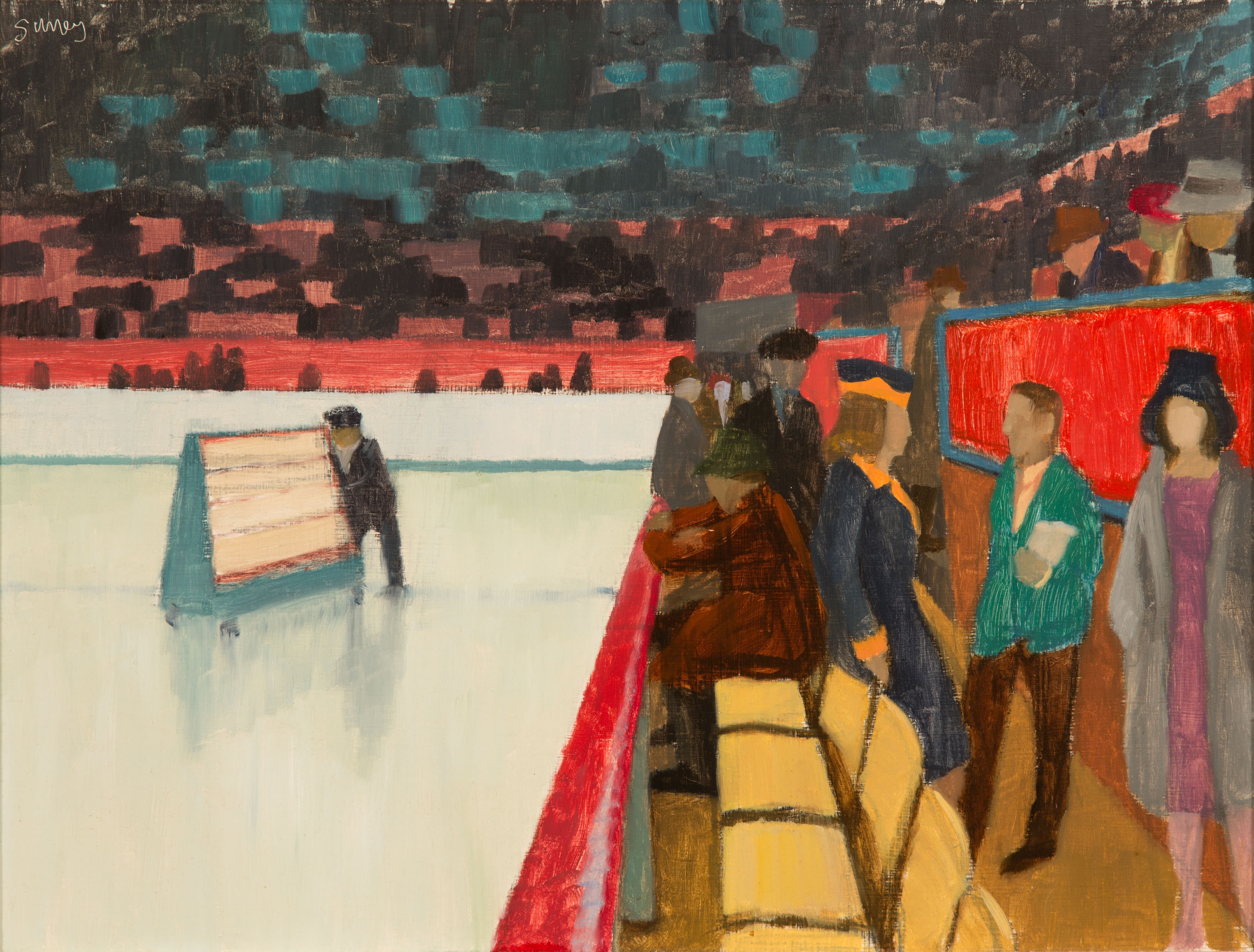
Lucky Numbers, Montreal Forum, 1955 (circa).
Oil on panel, 11 ½ x 15 ½ in (29.2 x 39.4 cm).
Private collection, not for sale.
"Austin (Dink) Carroll and his wife Margaret (Peggy) were near neighbours and good friends. Peggy was an extraordinary student of the game of hockey and served as Dink's ice level assistant while he was in the press box. He held season tickets to two ice level tickets beside the visitor's bench." Terry emailed me July 3, 2016.[25]
Many of today's Habs' fans may not recognize the event. Between periods at the Montreal Forum in the day, a billboard would be rolled out showing "Lucky Numbers". If one of those numbers matched the number of your programme, you won…. something. I can't tell you what, because I never won. Even here, in an arena of 16,000 fans, we find Surrey alone.
Changing Lines, Self Portrait 1960-1970 features John Bucyk #9, left wing, Phil Esposito #7, centre and Fred Stanfield #17, a centre man who sometimes played wing. (Or is it #12 Wayne Cashman, a natural winger?)
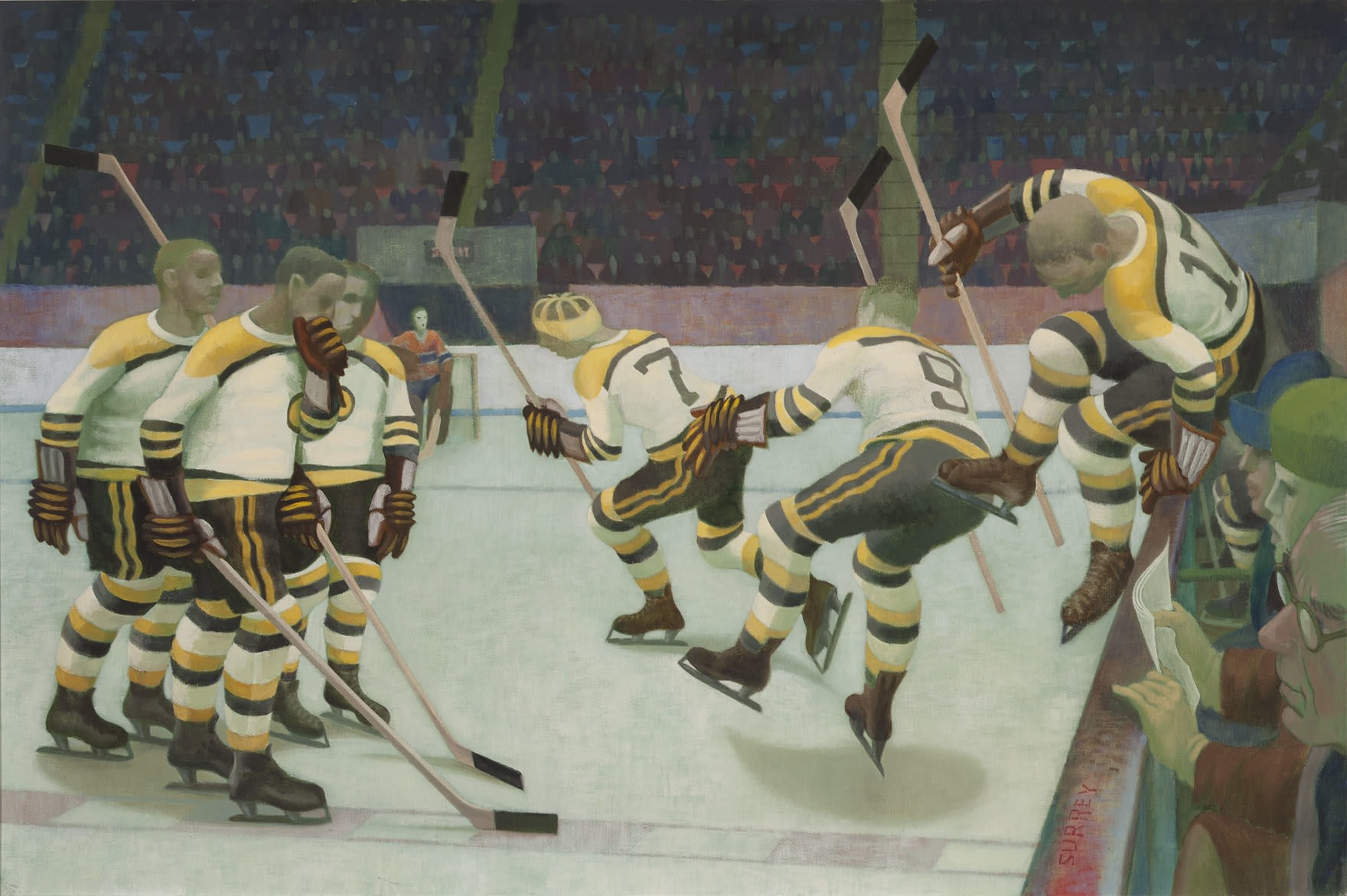
Changing Lines, Self Portrait 1960-1970, 1970 (circa). Oil on canvas, 24 x 36 in, 61 x 91.4 cm.
Private collection, not for sale.
That Boston team had the makings of a dynasty, winning the Stanley Cup in the 1969 -'70 campaign, should have won it but didn't in the '70-'71 season, and won it again in '71-'72. The team was coached by Tom Johnson, with players Johnny Bucyk, Phil Esposito, Wayne Cashman, Bobby Orr, Derek Sanderson, Ted Green, Reggie Leach, Ed Westfall, Ken Hodge, Fred Stanfield with Gerry Cheevers and Eddie Johnson as goalers.
As a Habs fan I need to add that the Boston team won so many honours at the end of the '70-71 season but not the cup! They finished 1st in the east division, the Habs miles behind in 3rd. Not to be overlooked, Montreal was led by Jean Beliveau, Henri Richard, the Mahovlich brothers, Mickey Redmond, Jacques Lemaire, Ralph Backstrom, Réjean Houle, Yvan Cournoyer, J.C. Tremblay protected by John Ferguson, Jacques Laperrière and Guy Lapointe to name a selection. The wild card was that after his season finished in the American Hockey League, Ken Dryden was called up to replace Phil Myre backing up Rogatien Vachon. To everyone's surprise, having played only six games with the club, Coach Al MacNeil chose to start Dryden in the series against Boston where he played brilliantly leading his team in their upset of Boston in a seven-game series, then Minnesota and finally Chicago to win the Stanley Cup.
Surrey does not paint documentaries and offers as an alternate title to this painting "self-portrait 1960-1970". Why the 1960-1970? As strictly conjecture, perhaps this relates to the fact that another of these rare and outstanding hockey scenes, maybe his first of this type, one with Les Canadiens vs Detroit, is a painting of 1960. Is there perhaps a deeper reference, the years 1960 and 1970 both extremely dark ones as concerns depressions?
Less known than his drawings, watercolours, pastels and paintings in oils are Surrey's etchings. While being accomplished in this medium, in the early 1960s, "I... decided...that I had no time for etching, which I had thought might be a good change from canvas"[26], he sold his press. It was too time consuming for him to resolve a composition in that medium that he found satisfying.
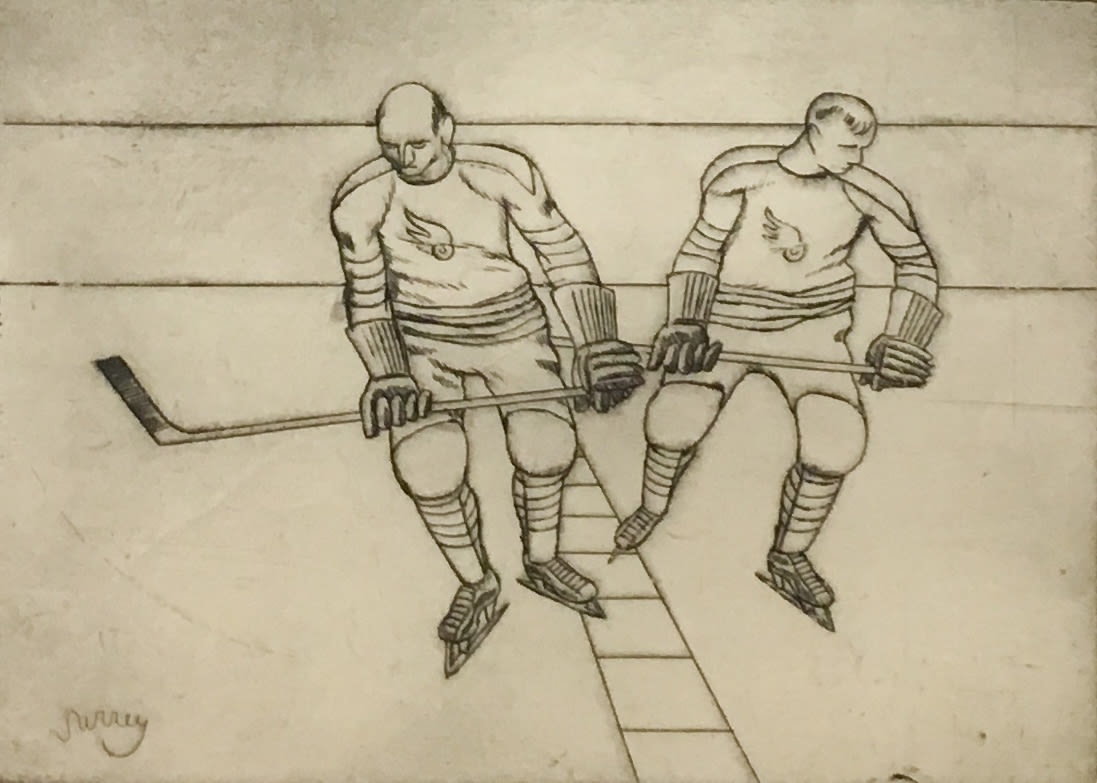
Detroit Red Wings Hockey Players, 1960 (circa). Etching, 5 x 6 ⅞ in (12.7 x 17.5 cm).
Private collection, not for sale.
Gilles Daigneault interviewed Surrey for Vie Des Arts in the fall of 1979. Gilles wrote, "During our conversation Surrey would speak frequently of his fundamental pessimism, saying that it is very difficult to be lucid and optimistic at the same time."[27]
In 2004, Galerie Walter Klinkhoff hosted an "Homage à Philip Surrey"[28], a non-selling exhibition in his honour. The exhibition was accompanied by a highly informative catalogue written by Terry Rigelhof, a former neighbour of Margaret and Philip Surrey. Mr. Rigelhof's research and study of Philip Surrey is ongoing. To our knowledge, the 2004 exhibition remains the largest collection of his work ever exhibited.
[1] Margaret Surrey, Biographical notes of Philip Surrey, Philip and Margaret Day Fonds, P85A, National Archives of Canada, Estate Philip Surrey.
[2] Ibid, p. 152-153
[3] Ibid, p. 157
[4] Ibid, p. 196
[5] Ibid, p. 141
[6] Ibid
[7] Patricia Whitney, "First Person Feminine: Margaret Day Surrey", accessible online: http://canadianpoetry.org/volumes/vol31/whitney.html
[8] The Westmount Examiner, May 10, 1990, author and page not noted
[9] Margaret Surrey, op. cit.
[10] The Westmount Examiner, op. cit.
[11] Margaret Surrey, op. cit.
[12] Margaret Surrey, op. cit., 132.
[13] Ibid, p. 133.
[14] Gilles Corbeil and Guy Viau, Philip Surrey : Le peintre dans la ville. Montréal: Musée d'art contemporain de Montréal; Paris, France: Centre culturel canadien, 1971.
[15] Margaret Surrey, op. cit.
[16] Robert Ayre, "City and the dream of Philip Surrey'', Canadian Art, Vol. 21, September 1964, p. 287
[17] Philip Surrey to Susan Carson, op. cit.
[18] Margaret Surrey, op. cit., p. 152.
[19] Ibid, p. 153.
[20] Gilles Daigneault, "The expressionism of Philip Surrey", Texts in English, Vie des Arts, Vol 24, No. 96, Fall 1979, p. 101.
[21] Philip Surrey to Susan Carson, op. cit.
[22] Jerrold Morris, The Nude in Canadian Painting, 1972,Toronto: New Press.
[23] Margaret Surrey, op. Cit., p. 151A
[24] Gilles Corbeil and Guy Viau, op. cit.
[25] Email from Terry Rigelhof to Alan Klinkhoff, July 3, 2016.
[26] Margaret Surrey, op. cit., p. 139.
[27] Daigneault, op. cit.
[28] Galerie Walter Klinkhoff, "Homage à Philip Surrey", 2004 with an essay by Terry Rigelhof



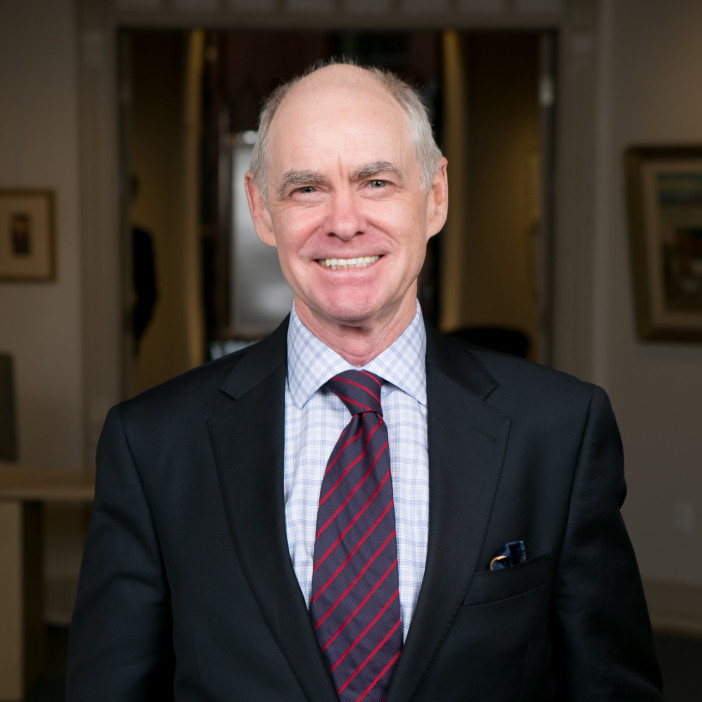
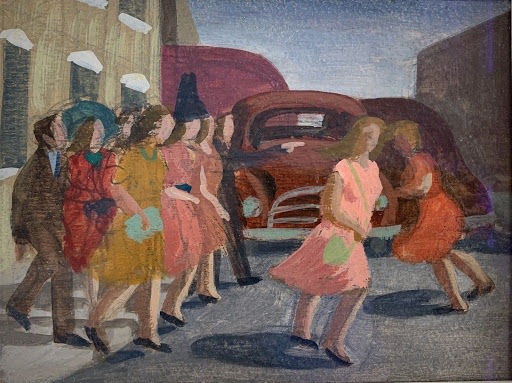 Pedestrians
Pedestrians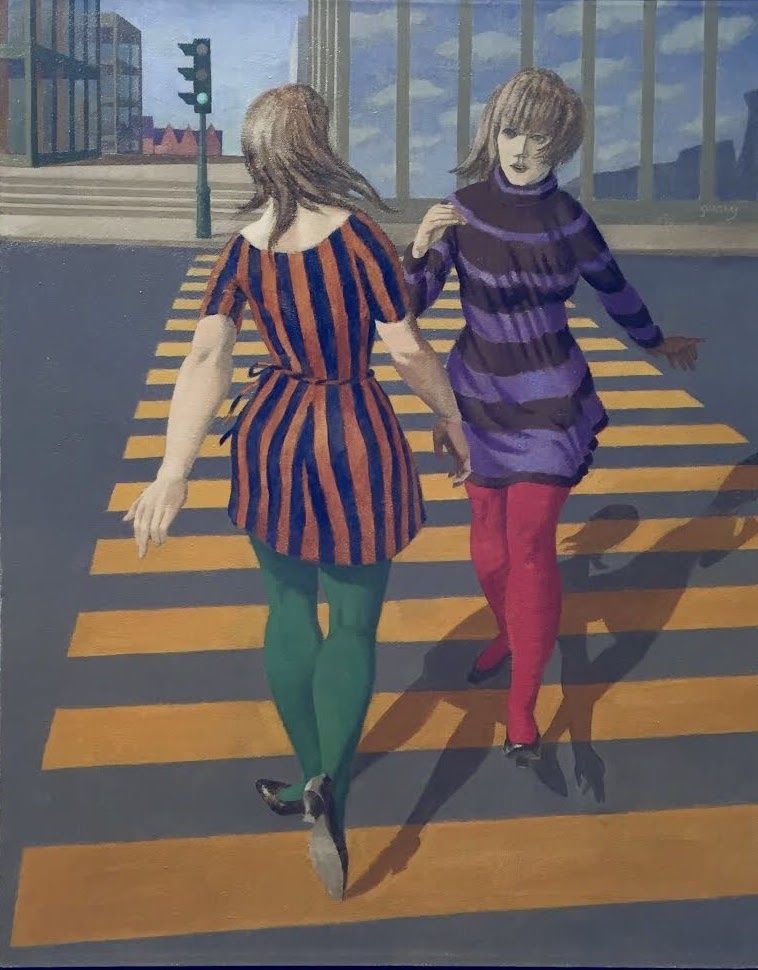
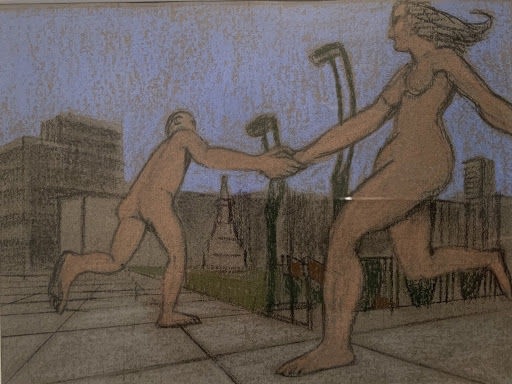
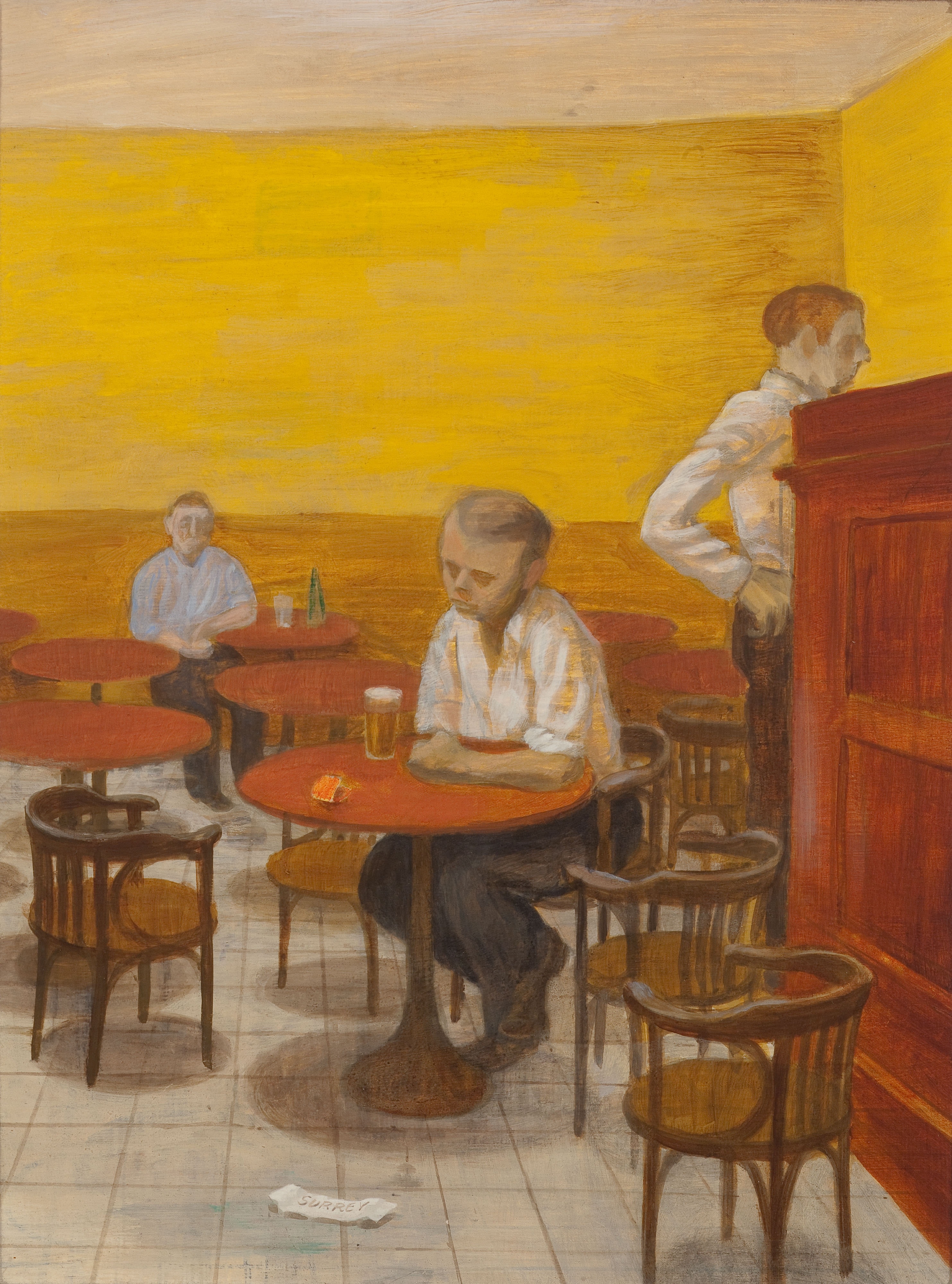

Add a comment